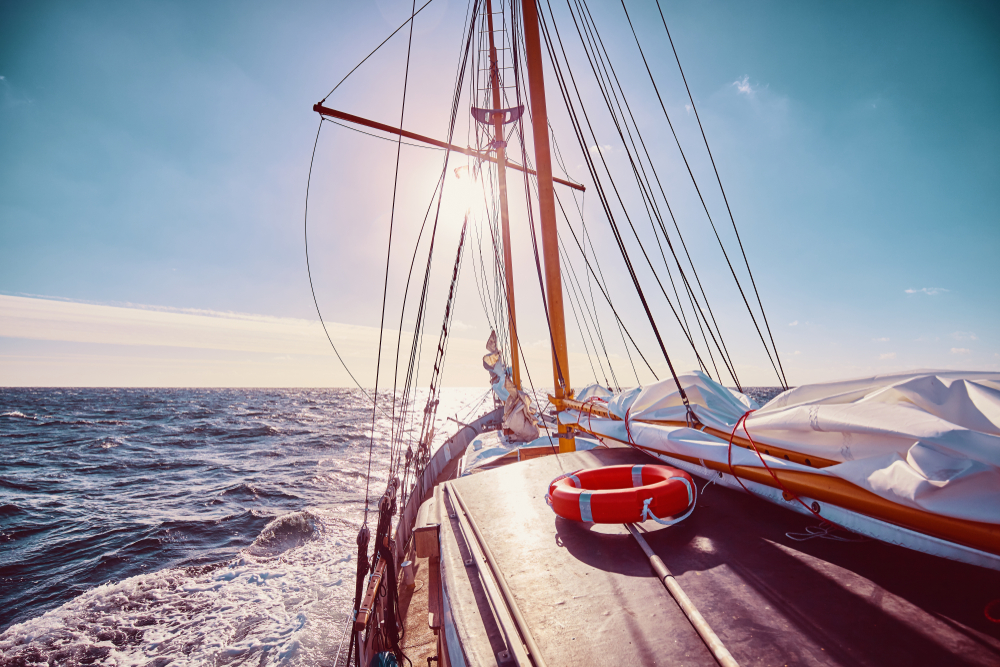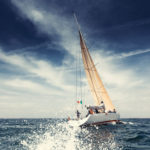Once the theory has been taken on board, novice sailors who do not have a boat licence must experience sailing for the first time, in complete safety. This is how the minimum level of sailor know-how and boat skills are acquired to then head out sailing the open sea on the sailing boat of your choice.
Reminder: when can you drive a boat without a licence?
At sea and in general, driving a boat without a licence is permitted if the boat is equipped with an engine with a power output of less than 4.5 kW (6 hp).
In France and on inland waterways, regulations allow sailing without a licence on board a river boat up to a maximum 15 metres long with a speed of 12 km/h or less.
The river boat, or how to enjoy your first experience!
The river boat is the first boat without a licence that comes to mind, to cruise down inland waterways (rivers and canals). The Canal du Midi, the Rhône-Rhine, Mayenne or Baie de Somme canals, etc. are all superb “boat rides”, with stunning landscapes and exceptional discoveries. You can enjoy cruises in every region in France!
These boats which don’t need a licence give you a first experience of sailing and an unusual stay. Living day and night on board the boat, amateur sailors enjoy life on board the same as sailing boats or motor boats sailing the salt sea water of the seas and oceans.
Most river boats are designed with engines from 30 to over 100 horsepower, for varying lengths up to a maximum of 15 metres. The cosy cabins are designed to make life on board comfortable. Navigation is simple and manoeuvring done using (only) two joystick controls. The navigation speed is around 6 kph, meaning it’s reassuring for skippers with little or no experience and enables the navigation experience to be worry-free as there is no risk.
Example of a river boat without a licence:
The “Tarpon” boat from the RECLA range is a river boat “made in France” by CPC boat builders, located in Burgundy, which the manufacturer presents as a “true second home”.
The solar-powered catamaran, or how to switch from freshwater to salt water!
Renting a solar-powered catamaran, in the South of France, and the Mediterranean, is an option for switching from a river boat to a sailing boat. It’s a way of moving on to sailing at sea.
Note that solar-powered boat has an electric motor, the energy for which is only provided by the sun.
Renting this type of boat without a licence requires theoretical and practical training that lasts for about one hour. Driving this boat without a licence doesn’t require any more time to be independent and go out to sea.
You’ll start sailing along the coast without taking an exam, needing a coastal licence or a certificate. Electric boats are smooth to drive and easy to manoeuvre.
Example of a solar-powered catamaran without a licence:
The SSR19 2.0 catamaran is a solar-powered boat manufactured in France (design and construction) which has total autonomy. The manufacturer presents its boat as one of the most “eco-cruisers in the world”.
The sailing boat, or how to get out on the big pond!
On board a sailing boat, recreational sailing without a boat licence doesn’t quite meet the same criteria. This is because many sailing boats have an engine with an output of more than 6 horsepower, but they do not require a boat licence to drive them for all that.
These boats must therefore be recognised as sailing boats and not as motor boats, which implies that the main propulsion of the boat is its sail and the boat only moves with the wind. In this case, the engine provides backup (when there’s no wind) and its use is occasional (manoeuvring in the port).
A sailing boat with measurements that conform to the following formula is a sailing boat:
As ≥ 0.07 (mLDC)2/3
As: sail area of all sails (m2 ).
mLDC: mass of the vessel in loaded condition (kg).
In France, therefore, a boat licence is not required by the maritime navigation code to drive a sailing boat, whether for sailing along the coast or out at sea.
Please note that the sailing boat must be equipped with a VHF marine radio to sail beyond the 6 nautical miles representing the border between coastal navigation and semi-high sea navigation (2017) and the skipper must have an RROC (Restricted Radiotelephone Operator Certificate).
The maritime RROC is valid for inland waterways if the boat (motor or sail) is equipped with a VHF marine radio, but the opposite is not true.
Sailing on a sailing boat is the ultimate step for sailors without a boat licence!
Example of a sailing boat equipped with an engine:
The ABSOLUTE SPA “52 Navetta” is a sailing boat equipped with a 75 horsepower Volvo D2-75 IB engine.
But this boat is classified as a sailing boat because the sailing area is greater than 39.18 m² and therefore a boat licence is not required to drive it.
Recreational boating is within reach and to sail with peace of mind, never forget that safety should be your top priority!





